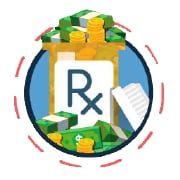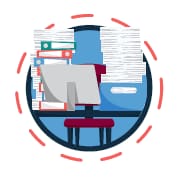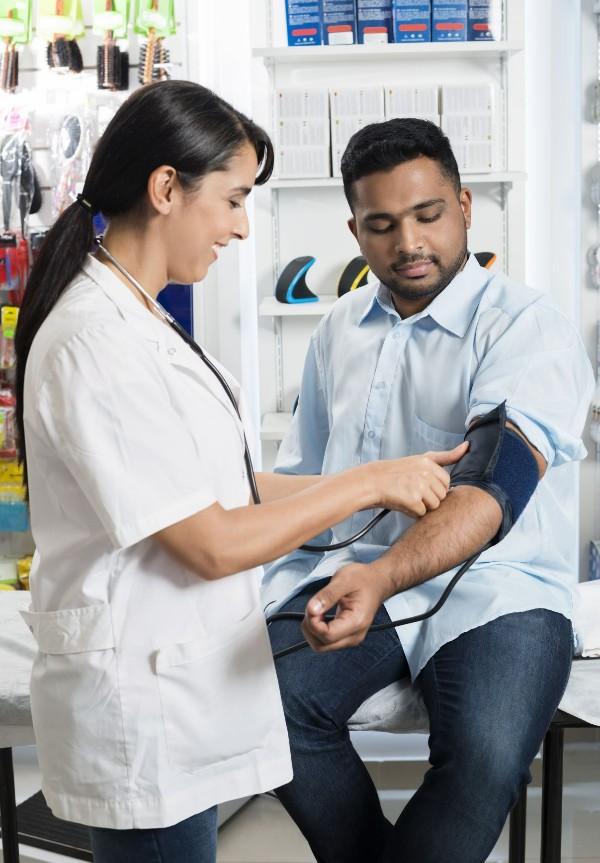Heart Disease and Stroke
More than 877,500 Americans die of heart disease, stroke, or other cardiovascular diseases every year. Heart disease and stroke are the first and fifth leading causes of death in the United States.
CDC supports programs that help millions of Americans control their high blood pressure, prevent risk factors for heart disease and stroke, and reduce health disparities, which are differences in health across different geographic, racial, ethnic, and socioeconomic groups. These efforts have helped lower death rates from heart disease and stroke.
Fast Stats
In the United States, cardiovascular diseases cause:

1 IN 3 DEATHS
or more than 859,000
people each year.

$216 BILLION
in health care system costs.

$147 BILLION
in lost productivity
on the job from
premature death.
The Nation’s Risk Factors and CDC’s Response
Leading risk factors for heart disease and stroke are high blood pressure, high low-density lipoprotein (LDL) cholesterol, diabetes, smoking and secondhand smoke exposure, obesity, unhealthy diet, and physical inactivity.
High Blood Pressure and High Cholesterol

High blood pressure is a leading cause of heart disease and stroke because it damages the lining of the arteries, making them more susceptible to the buildup of plaque, which narrows the arteries leading to the heart and brain. About 116 million US adults (nearly 1 in 2) have high blood pressure, defined as 130/80 mm Hg or higher. Only about 1 in 4 of these people have their high blood pressure under control. About 7 in 10 people who have a first heart attack and 8 in 10 people who have a first stroke have high blood pressure.
Eating too much sodium can lead to high blood pressure. Americans aged 2 years or older consume an average of about 3,400 mg of sodium each day, well over the 2,300 mg recommended by the Dietary Guidelines for Americans. More than 70% of the sodium Americans consume is added outside the home (before purchase), not added as salt at the table or during home cooking.
High LDL cholesterol can double a person’s risk of heart disease. That’s because excess cholesterol can build up in the walls of arteries and limit blood flow to a person’s heart, brain, kidneys, other organs, and legs. Although nearly 86 million US adults could benefit from taking medicine to manage their high LDL cholesterol, only about half (55%) are doing so.
People can improve their blood pressure and cholesterol levels by eating a healthy diet that is low in sodium, being physically active, maintaining a healthy weight, and taking medicines as recommended.
CDC’s Response
CDC’s Division for Heart Disease and Stroke Prevention (DHDSP) works with partners across government, public health, health care, and private sectors to improve prevention, detection, and control of heart disease and stroke risk factors, with a focus on high blood pressure and high cholesterol. DHDSP also works to improve recognition of the signs and symptoms of a heart attack or stroke and the quality of care prior to and following these events.
Through its scientific and programmatic investments, DHDSP advances proven strategies such as using electronic health records to identify patients at risk and using teams to deliver high-quality care. These teams extend beyond the doctors and nurses to include pharmacists, community health workers, and others outside of the doctor’s office. The division also promotes strategies that link patients to community programs and resources that help them take their medicines consistently, manage their risks, and make healthy lifestyle changes, such as quitting smoking, becoming more physically active, or losing weight.
The following major programs support the division’s goals:
- DHDSP funds heart disease and stroke prevention and management activities in all 50 states, the District of Columbia, 12 tribes, 23 tribal-serving organizations, 5 large cities or counties, and 2 groups of city and county health departments. These programs work to reduce risk factors for heart disease and stroke and eliminate health disparities through community and health system interventions.
- WISEWOMAN funds 21 states and 3 tribal organizations to reduce heart disease and stroke risk factors for women aged 40 to 64 with low incomes and little or no health insurance.
- The Paul Coverdell National Acute Stroke Program funds 13 states to use coordinated systems of care to improve the quality of care for patients who have a stroke.
Million Hearts® provides national leadership to promote changes in communities and health care systems across the country to prevent heart attacks and strokes.
Diabetes
Adults with diabetes are twice as likely to have heart disease or a stroke as people who do not have diabetes. Over time, high blood sugar from diabetes can damage blood vessels in the heart and block blood vessels leading to the brain, causing a stroke. More than 2 in 3 people with diabetes have high blood pressure. Diabetes also raises triglycerides and LDL cholesterol.
CDC’s Response
CDC’s Division of Diabetes Translation is at the leading edge of the nation’s efforts to help people prevent and manage diabetes. The division works with federal, state, and community organizations to prevent type 2 diabetes and improve the health of all people with diabetes.
The CDC-led National Diabetes Prevention Program delivers an evidence-based lifestyle change program to help adults with prediabetes prevent or delay type 2 diabetes. In partnership with the American Medical Association and the Ad Council, CDC leads the award-winning Do I Have Prediabetes campaign—the first ever to raise awareness across the nation about prediabetes. The campaign encourages people to find out their risk by taking a 1-minute test at DoIHavePrediabetes.org.
CDC also works to increase access to diabetes self-management education and support (DSMES) services. DSMES services can help people with diabetes better manage their blood sugar levels, reduce their risk for complications, reduce or eliminate the need for medications and emergency room visits, and access cost-savings programs.
These activities support CDC’s overall efforts to reduce death rates from heart disease and stroke by preventing and controlling risk factors.
Smoking and Secondhand Smoke Exposure

Smoking is a major cause of heart disease and stroke and causes 1 in every 4 deaths from these conditions. Smoking can damage the body several ways by:
- Raising triglycerides (a type of fat in the blood) and lowering high-density lipoprotein (HDL) cholesterol, also called “good” cholesterol.
- Making blood sticky and more likely to clot, which can block blood flow to the heart and brain.
- Damaging cells that line the blood vessels.
- Increasing the buildup of plaque (fat, cholesterol, calcium, and other substances) in blood vessels.
- Causing thickening and narrowing of blood vessels.
About 34 million US adults smoke cigarettes, and every day, about 1,600 young people under age 18 try their first cigarette.
CDC’s Response
CDC’s Office on Smoking and Health is at the forefront of the nation’s efforts to reduce deaths and prevent chronic diseases that result from commercial* tobacco use, including heart disease and stroke. OSH prioritizes health equity by creating resources and opportunities for all people to be as healthy as possible.
CDC and its partners promote efforts to:
- Prevent young people from starting to use tobacco.
- Promote quitting among adults and young people.
- Reduce people’s exposure to secondhand smoke.
- Advance health equity by identifying and eliminating tobacco-related disparities.
CDC’s Tips From Former Smokers® (Tips®) campaign, the first federally funded tobacco education campaign, focuses on motivating US adults who smoke to try to quit. Tips features real people who are living with serious health conditions caused by smoking and secondhand smoke exposure. The newest Tips series compelling stories from family members who take care of loved ones affected by a smoking-related disease or disability.
Tips connects people who smoke with resources to help them quit, including 1-800-QUIT-NOW, which directs people to free services from their state quitlines.
* When CDC references tobacco on this web page, we are referring to the use of commercial tobacco and not the sacred and traditional use of tobacco by some American Indian communities.
Obesity, Unhealthy Diet, and Physical Inactivity

Compared to those at a normal weight, people with overweight or obesity are at increased risk of heart disease and stroke and their risk factors, including high blood pressure, high LDL cholesterol, low HDL cholesterol, high triglycerides, and type 2 diabetes. In the United States, nearly 74% of adults have overweight or obesity.
A healthy diet can reduce a person’s chances of getting heart disease. A healthy diet emphasizes fruits and vegetables, whole grains, low-fat dairy products and lean proteins and limits saturated and trans fat, added sugars, and sodium.
Physical inactivity can also lead to heart disease—even for people who have no other risk factors. It can increase the chance of other risk factors, including obesity, high blood pressure, high cholesterol, and type 2 diabetes. Only 24% of adults and 16.5% of high school students meet the guidelines for aerobic and muscle-strengthening activity.
CDC’s Response
CDC’s Division of Nutrition, Physical Activity, and Obesity develops and shares proven approaches that make healthy living easier for everyone, which can help people reduce their risk of heart disease and stroke. For example, the division works with hospitals to support breastfeeding moms, early care and education (ECE) centers to promote healthy eating standards, and workplaces to change policies so that employees have more healthy food choices.
To increase physical activity opportunities, the division partners with states and communities to promote improvements in equitable community design. For example, sidewalks and parks make physical activity safer and more convenient for people of all ages and abilities.
